Comprehensive Report: Tort Law Principles in Australian Legal Context
VerifiedAdded on 2020/02/03
|8
|2555
|55
Report
AI Summary
This report provides a comprehensive overview of tort law principles within the Australian legal system. It defines tort law as a civil wrong, differentiating it from criminal law and contract breaches, and examines various types of torts, including negligence and defamation, highlighting the plaintiff's ability to claim damages. The report delves into the influence of common law, particularly from the United Kingdom, on Australian legal practices. It explores key principles such as the duty of care, the impact of case laws like Donoghue v Stevenson and Phillips v Eyre, and the differences between Australian and European legal systems. The analysis covers the evolution of tort law, statutory alterations, and specific considerations like trespass, the burden of proof, and the application of salient features in determining duty. The report also addresses complexities in legal actions and limitations within the Australian legal system. This report serves as an essential resource for understanding tort law and its applications.
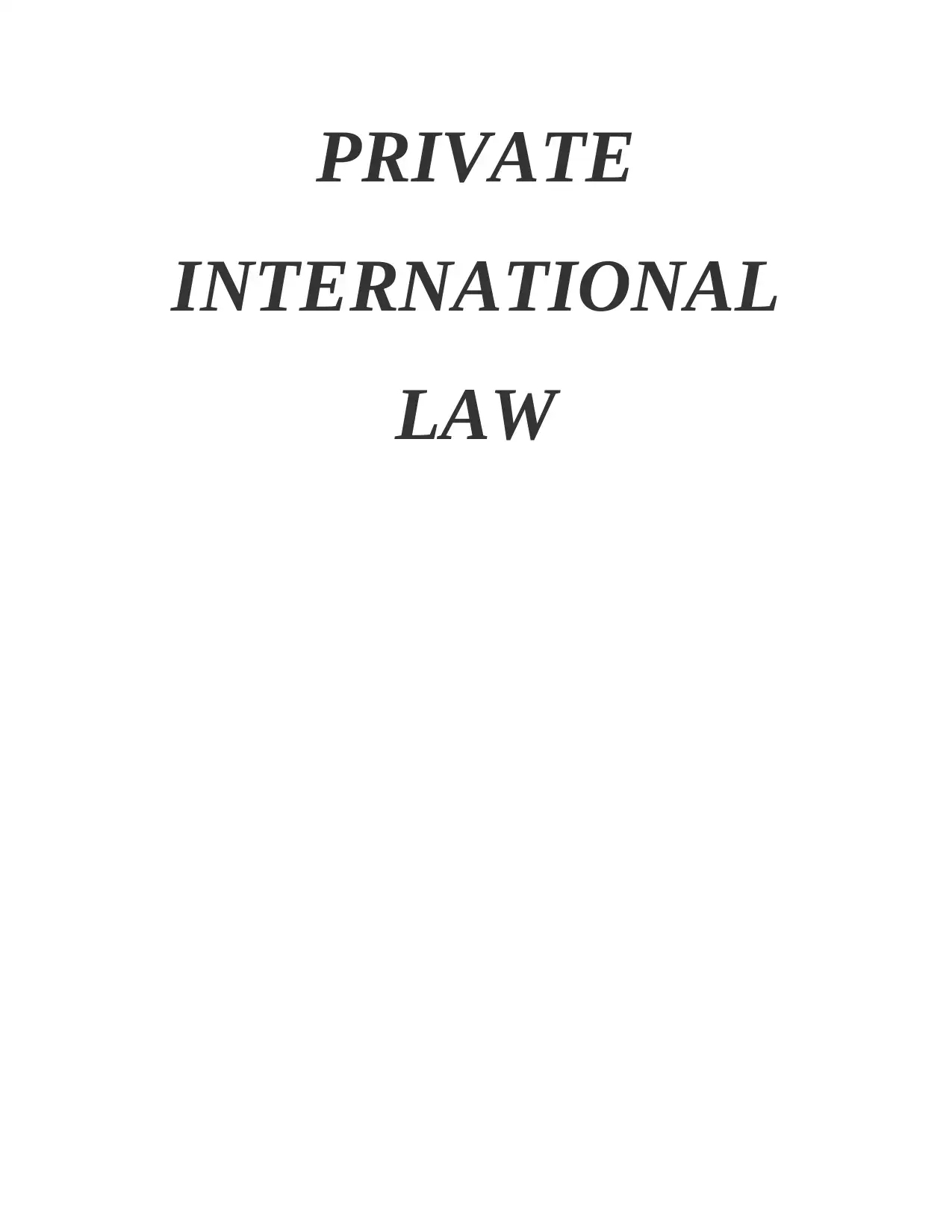
PRIVATE
INTERNATIONAL
LAW
INTERNATIONAL
LAW
Paraphrase This Document
Need a fresh take? Get an instant paraphrase of this document with our AI Paraphraser
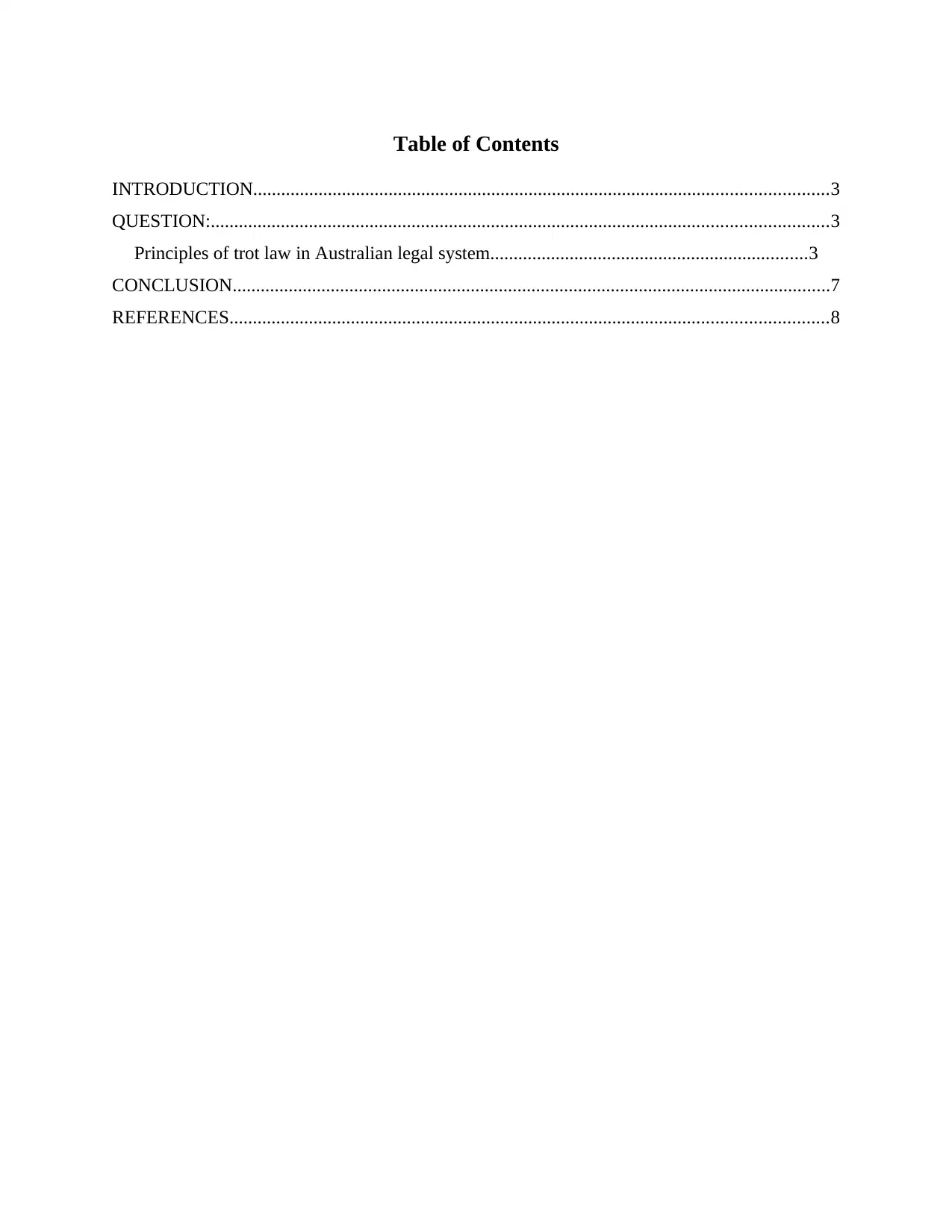
Table of Contents
INTRODUCTION...........................................................................................................................3
QUESTION:....................................................................................................................................3
Principles of trot law in Australian legal system....................................................................3
CONCLUSION................................................................................................................................7
REFERENCES................................................................................................................................8
INTRODUCTION...........................................................................................................................3
QUESTION:....................................................................................................................................3
Principles of trot law in Australian legal system....................................................................3
CONCLUSION................................................................................................................................7
REFERENCES................................................................................................................................8
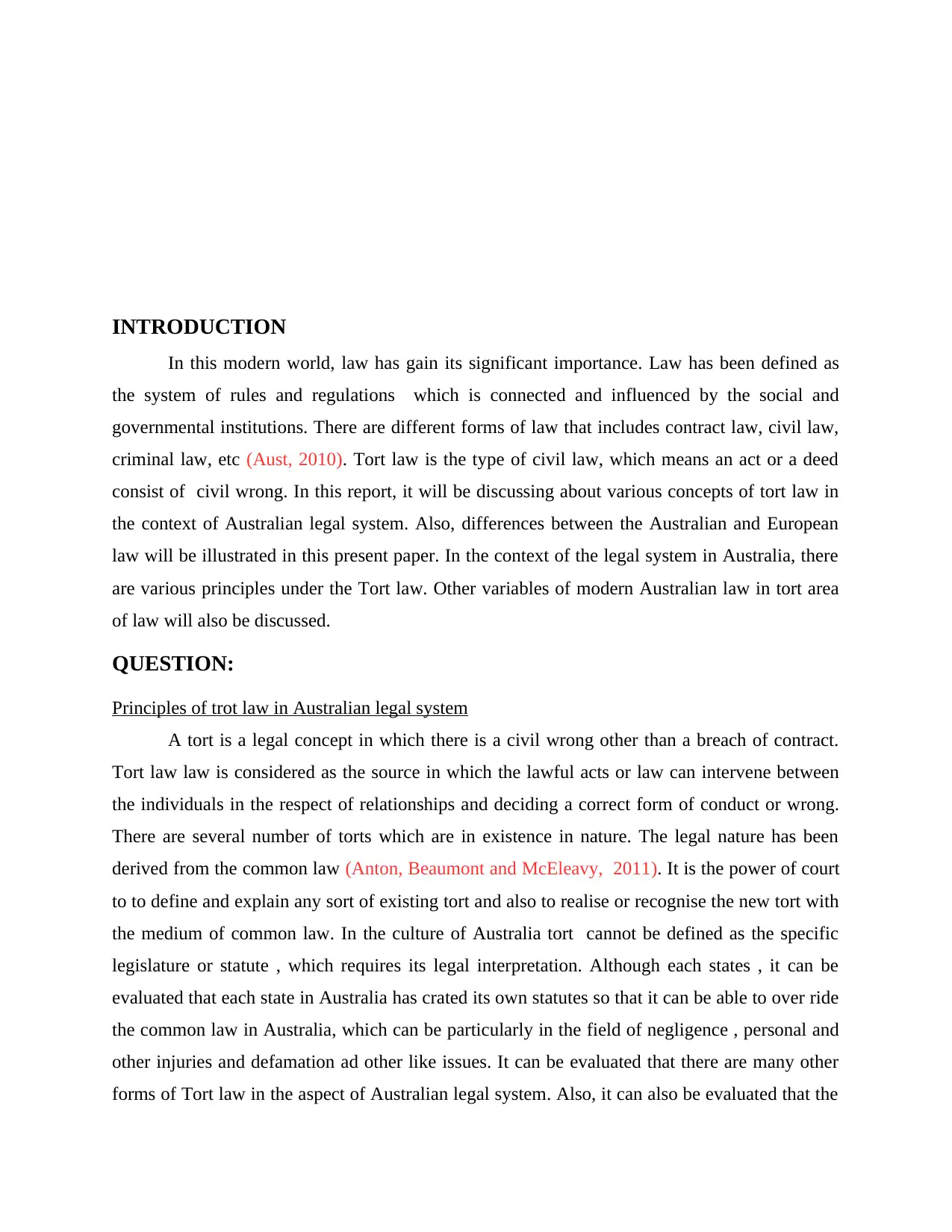
INTRODUCTION
In this modern world, law has gain its significant importance. Law has been defined as
the system of rules and regulations which is connected and influenced by the social and
governmental institutions. There are different forms of law that includes contract law, civil law,
criminal law, etc (Aust, 2010). Tort law is the type of civil law, which means an act or a deed
consist of civil wrong. In this report, it will be discussing about various concepts of tort law in
the context of Australian legal system. Also, differences between the Australian and European
law will be illustrated in this present paper. In the context of the legal system in Australia, there
are various principles under the Tort law. Other variables of modern Australian law in tort area
of law will also be discussed.
QUESTION:
Principles of trot law in Australian legal system
A tort is a legal concept in which there is a civil wrong other than a breach of contract.
Tort law law is considered as the source in which the lawful acts or law can intervene between
the individuals in the respect of relationships and deciding a correct form of conduct or wrong.
There are several number of torts which are in existence in nature. The legal nature has been
derived from the common law (Anton, Beaumont and McEleavy, 2011). It is the power of court
to to define and explain any sort of existing tort and also to realise or recognise the new tort with
the medium of common law. In the culture of Australia tort cannot be defined as the specific
legislature or statute , which requires its legal interpretation. Although each states , it can be
evaluated that each state in Australia has crated its own statutes so that it can be able to over ride
the common law in Australia, which can be particularly in the field of negligence , personal and
other injuries and defamation ad other like issues. It can be evaluated that there are many other
forms of Tort law in the aspect of Australian legal system. Also, it can also be evaluated that the
In this modern world, law has gain its significant importance. Law has been defined as
the system of rules and regulations which is connected and influenced by the social and
governmental institutions. There are different forms of law that includes contract law, civil law,
criminal law, etc (Aust, 2010). Tort law is the type of civil law, which means an act or a deed
consist of civil wrong. In this report, it will be discussing about various concepts of tort law in
the context of Australian legal system. Also, differences between the Australian and European
law will be illustrated in this present paper. In the context of the legal system in Australia, there
are various principles under the Tort law. Other variables of modern Australian law in tort area
of law will also be discussed.
QUESTION:
Principles of trot law in Australian legal system
A tort is a legal concept in which there is a civil wrong other than a breach of contract.
Tort law law is considered as the source in which the lawful acts or law can intervene between
the individuals in the respect of relationships and deciding a correct form of conduct or wrong.
There are several number of torts which are in existence in nature. The legal nature has been
derived from the common law (Anton, Beaumont and McEleavy, 2011). It is the power of court
to to define and explain any sort of existing tort and also to realise or recognise the new tort with
the medium of common law. In the culture of Australia tort cannot be defined as the specific
legislature or statute , which requires its legal interpretation. Although each states , it can be
evaluated that each state in Australia has crated its own statutes so that it can be able to over ride
the common law in Australia, which can be particularly in the field of negligence , personal and
other injuries and defamation ad other like issues. It can be evaluated that there are many other
forms of Tort law in the aspect of Australian legal system. Also, it can also be evaluated that the
⊘ This is a preview!⊘
Do you want full access?
Subscribe today to unlock all pages.

Trusted by 1+ million students worldwide
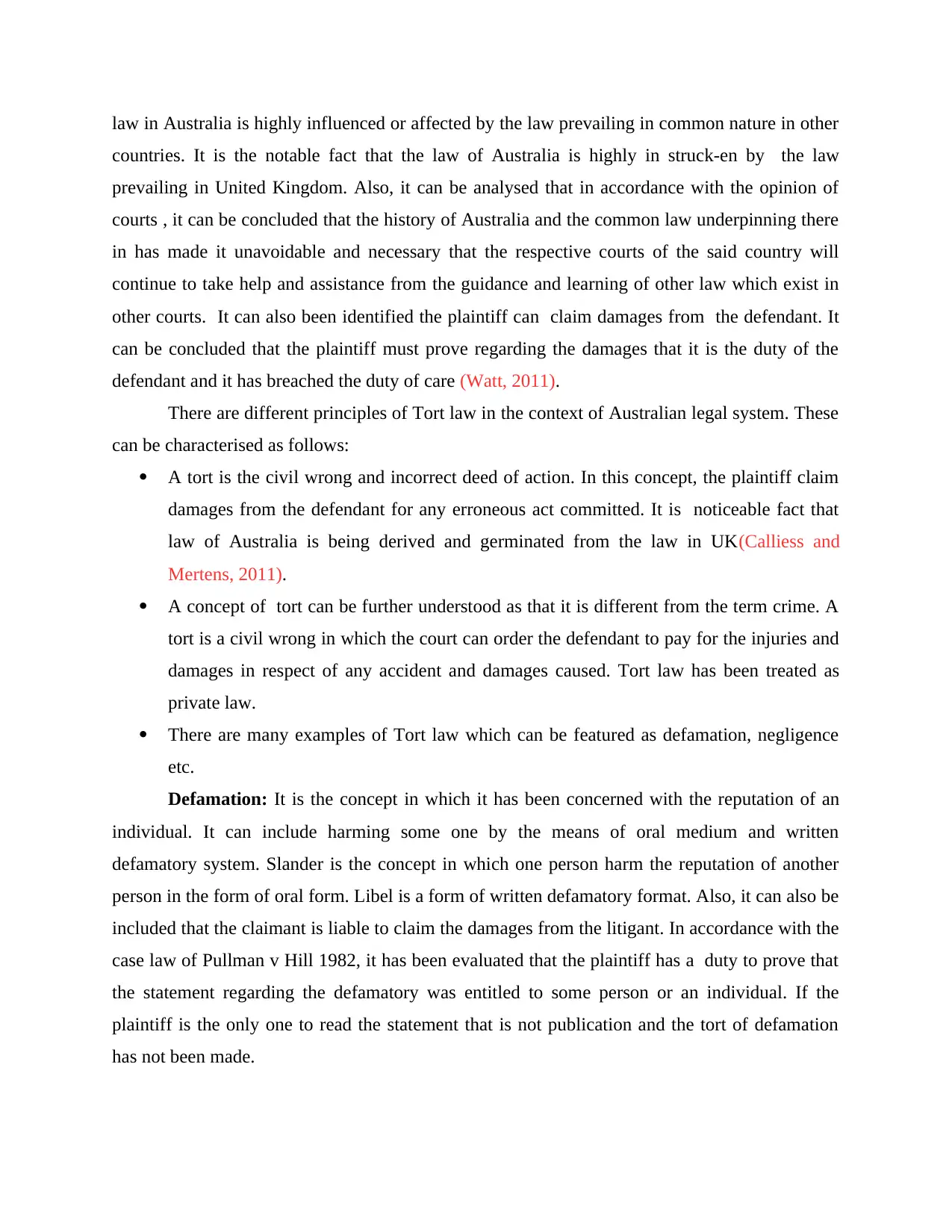
law in Australia is highly influenced or affected by the law prevailing in common nature in other
countries. It is the notable fact that the law of Australia is highly in struck-en by the law
prevailing in United Kingdom. Also, it can be analysed that in accordance with the opinion of
courts , it can be concluded that the history of Australia and the common law underpinning there
in has made it unavoidable and necessary that the respective courts of the said country will
continue to take help and assistance from the guidance and learning of other law which exist in
other courts. It can also been identified the plaintiff can claim damages from the defendant. It
can be concluded that the plaintiff must prove regarding the damages that it is the duty of the
defendant and it has breached the duty of care (Watt, 2011).
There are different principles of Tort law in the context of Australian legal system. These
can be characterised as follows:
A tort is the civil wrong and incorrect deed of action. In this concept, the plaintiff claim
damages from the defendant for any erroneous act committed. It is noticeable fact that
law of Australia is being derived and germinated from the law in UK(Calliess and
Mertens, 2011).
A concept of tort can be further understood as that it is different from the term crime. A
tort is a civil wrong in which the court can order the defendant to pay for the injuries and
damages in respect of any accident and damages caused. Tort law has been treated as
private law.
There are many examples of Tort law which can be featured as defamation, negligence
etc.
Defamation: It is the concept in which it has been concerned with the reputation of an
individual. It can include harming some one by the means of oral medium and written
defamatory system. Slander is the concept in which one person harm the reputation of another
person in the form of oral form. Libel is a form of written defamatory format. Also, it can also be
included that the claimant is liable to claim the damages from the litigant. In accordance with the
case law of Pullman v Hill 1982, it has been evaluated that the plaintiff has a duty to prove that
the statement regarding the defamatory was entitled to some person or an individual. If the
plaintiff is the only one to read the statement that is not publication and the tort of defamation
has not been made.
countries. It is the notable fact that the law of Australia is highly in struck-en by the law
prevailing in United Kingdom. Also, it can be analysed that in accordance with the opinion of
courts , it can be concluded that the history of Australia and the common law underpinning there
in has made it unavoidable and necessary that the respective courts of the said country will
continue to take help and assistance from the guidance and learning of other law which exist in
other courts. It can also been identified the plaintiff can claim damages from the defendant. It
can be concluded that the plaintiff must prove regarding the damages that it is the duty of the
defendant and it has breached the duty of care (Watt, 2011).
There are different principles of Tort law in the context of Australian legal system. These
can be characterised as follows:
A tort is the civil wrong and incorrect deed of action. In this concept, the plaintiff claim
damages from the defendant for any erroneous act committed. It is noticeable fact that
law of Australia is being derived and germinated from the law in UK(Calliess and
Mertens, 2011).
A concept of tort can be further understood as that it is different from the term crime. A
tort is a civil wrong in which the court can order the defendant to pay for the injuries and
damages in respect of any accident and damages caused. Tort law has been treated as
private law.
There are many examples of Tort law which can be featured as defamation, negligence
etc.
Defamation: It is the concept in which it has been concerned with the reputation of an
individual. It can include harming some one by the means of oral medium and written
defamatory system. Slander is the concept in which one person harm the reputation of another
person in the form of oral form. Libel is a form of written defamatory format. Also, it can also be
included that the claimant is liable to claim the damages from the litigant. In accordance with the
case law of Pullman v Hill 1982, it has been evaluated that the plaintiff has a duty to prove that
the statement regarding the defamatory was entitled to some person or an individual. If the
plaintiff is the only one to read the statement that is not publication and the tort of defamation
has not been made.
Paraphrase This Document
Need a fresh take? Get an instant paraphrase of this document with our AI Paraphraser
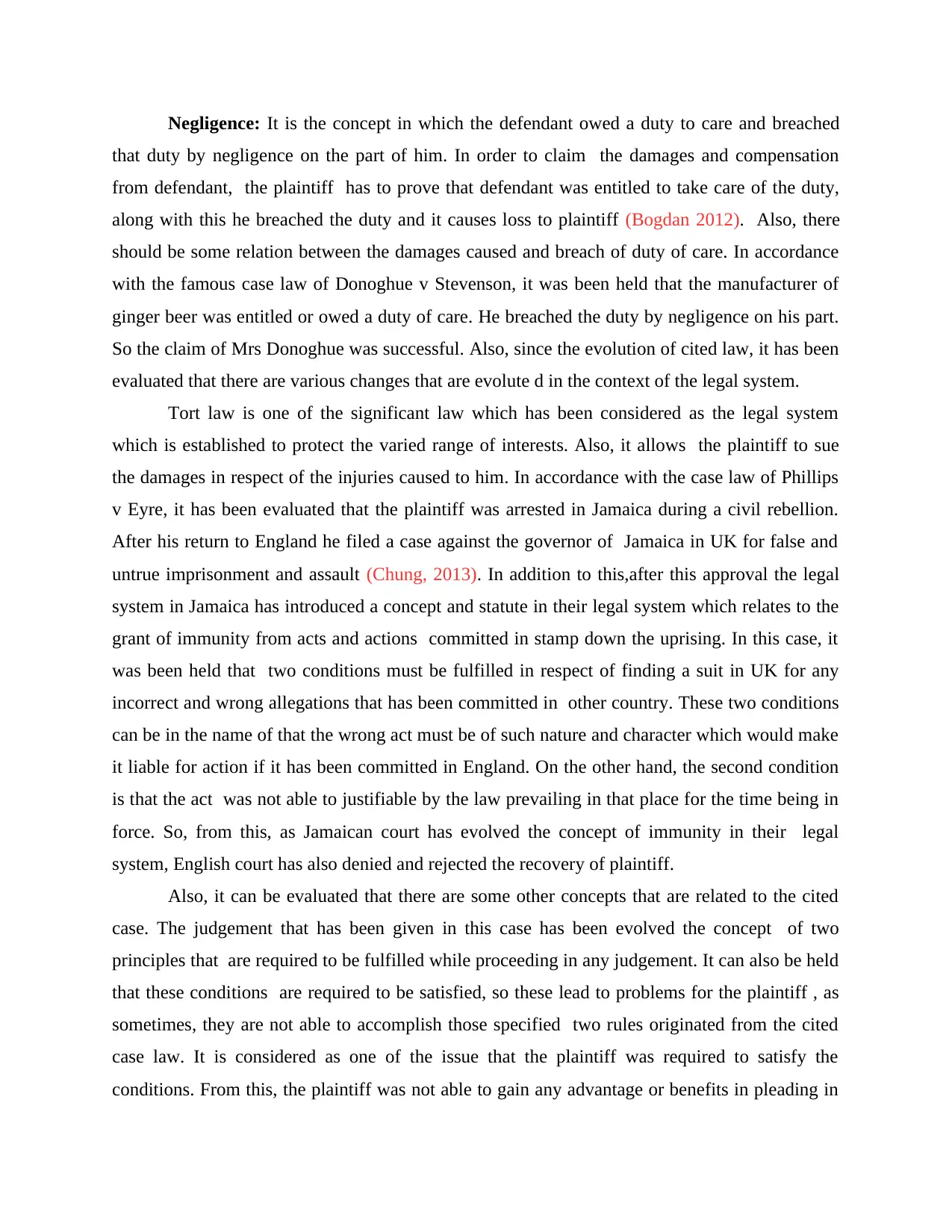
Negligence: It is the concept in which the defendant owed a duty to care and breached
that duty by negligence on the part of him. In order to claim the damages and compensation
from defendant, the plaintiff has to prove that defendant was entitled to take care of the duty,
along with this he breached the duty and it causes loss to plaintiff (Bogdan 2012). Also, there
should be some relation between the damages caused and breach of duty of care. In accordance
with the famous case law of Donoghue v Stevenson, it was been held that the manufacturer of
ginger beer was entitled or owed a duty of care. He breached the duty by negligence on his part.
So the claim of Mrs Donoghue was successful. Also, since the evolution of cited law, it has been
evaluated that there are various changes that are evolute d in the context of the legal system.
Tort law is one of the significant law which has been considered as the legal system
which is established to protect the varied range of interests. Also, it allows the plaintiff to sue
the damages in respect of the injuries caused to him. In accordance with the case law of Phillips
v Eyre, it has been evaluated that the plaintiff was arrested in Jamaica during a civil rebellion.
After his return to England he filed a case against the governor of Jamaica in UK for false and
untrue imprisonment and assault (Chung, 2013). In addition to this,after this approval the legal
system in Jamaica has introduced a concept and statute in their legal system which relates to the
grant of immunity from acts and actions committed in stamp down the uprising. In this case, it
was been held that two conditions must be fulfilled in respect of finding a suit in UK for any
incorrect and wrong allegations that has been committed in other country. These two conditions
can be in the name of that the wrong act must be of such nature and character which would make
it liable for action if it has been committed in England. On the other hand, the second condition
is that the act was not able to justifiable by the law prevailing in that place for the time being in
force. So, from this, as Jamaican court has evolved the concept of immunity in their legal
system, English court has also denied and rejected the recovery of plaintiff.
Also, it can be evaluated that there are some other concepts that are related to the cited
case. The judgement that has been given in this case has been evolved the concept of two
principles that are required to be fulfilled while proceeding in any judgement. It can also be held
that these conditions are required to be satisfied, so these lead to problems for the plaintiff , as
sometimes, they are not able to accomplish those specified two rules originated from the cited
case law. It is considered as one of the issue that the plaintiff was required to satisfy the
conditions. From this, the plaintiff was not able to gain any advantage or benefits in pleading in
that duty by negligence on the part of him. In order to claim the damages and compensation
from defendant, the plaintiff has to prove that defendant was entitled to take care of the duty,
along with this he breached the duty and it causes loss to plaintiff (Bogdan 2012). Also, there
should be some relation between the damages caused and breach of duty of care. In accordance
with the famous case law of Donoghue v Stevenson, it was been held that the manufacturer of
ginger beer was entitled or owed a duty of care. He breached the duty by negligence on his part.
So the claim of Mrs Donoghue was successful. Also, since the evolution of cited law, it has been
evaluated that there are various changes that are evolute d in the context of the legal system.
Tort law is one of the significant law which has been considered as the legal system
which is established to protect the varied range of interests. Also, it allows the plaintiff to sue
the damages in respect of the injuries caused to him. In accordance with the case law of Phillips
v Eyre, it has been evaluated that the plaintiff was arrested in Jamaica during a civil rebellion.
After his return to England he filed a case against the governor of Jamaica in UK for false and
untrue imprisonment and assault (Chung, 2013). In addition to this,after this approval the legal
system in Jamaica has introduced a concept and statute in their legal system which relates to the
grant of immunity from acts and actions committed in stamp down the uprising. In this case, it
was been held that two conditions must be fulfilled in respect of finding a suit in UK for any
incorrect and wrong allegations that has been committed in other country. These two conditions
can be in the name of that the wrong act must be of such nature and character which would make
it liable for action if it has been committed in England. On the other hand, the second condition
is that the act was not able to justifiable by the law prevailing in that place for the time being in
force. So, from this, as Jamaican court has evolved the concept of immunity in their legal
system, English court has also denied and rejected the recovery of plaintiff.
Also, it can be evaluated that there are some other concepts that are related to the cited
case. The judgement that has been given in this case has been evolved the concept of two
principles that are required to be fulfilled while proceeding in any judgement. It can also be held
that these conditions are required to be satisfied, so these lead to problems for the plaintiff , as
sometimes, they are not able to accomplish those specified two rules originated from the cited
case law. It is considered as one of the issue that the plaintiff was required to satisfy the
conditions. From this, the plaintiff was not able to gain any advantage or benefits in pleading in
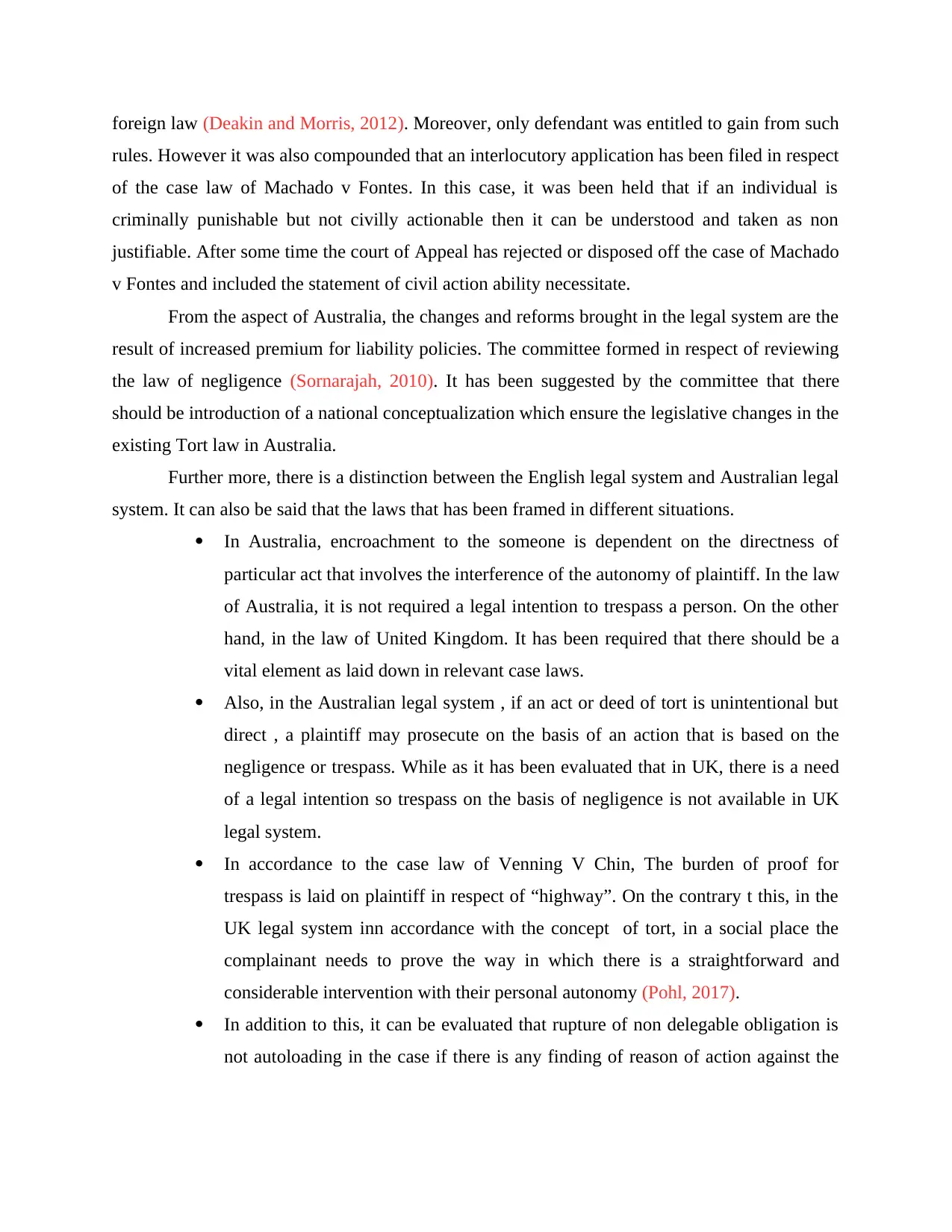
foreign law (Deakin and Morris, 2012). Moreover, only defendant was entitled to gain from such
rules. However it was also compounded that an interlocutory application has been filed in respect
of the case law of Machado v Fontes. In this case, it was been held that if an individual is
criminally punishable but not civilly actionable then it can be understood and taken as non
justifiable. After some time the court of Appeal has rejected or disposed off the case of Machado
v Fontes and included the statement of civil action ability necessitate.
From the aspect of Australia, the changes and reforms brought in the legal system are the
result of increased premium for liability policies. The committee formed in respect of reviewing
the law of negligence (Sornarajah, 2010). It has been suggested by the committee that there
should be introduction of a national conceptualization which ensure the legislative changes in the
existing Tort law in Australia.
Further more, there is a distinction between the English legal system and Australian legal
system. It can also be said that the laws that has been framed in different situations.
In Australia, encroachment to the someone is dependent on the directness of
particular act that involves the interference of the autonomy of plaintiff. In the law
of Australia, it is not required a legal intention to trespass a person. On the other
hand, in the law of United Kingdom. It has been required that there should be a
vital element as laid down in relevant case laws.
Also, in the Australian legal system , if an act or deed of tort is unintentional but
direct , a plaintiff may prosecute on the basis of an action that is based on the
negligence or trespass. While as it has been evaluated that in UK, there is a need
of a legal intention so trespass on the basis of negligence is not available in UK
legal system.
In accordance to the case law of Venning V Chin, The burden of proof for
trespass is laid on plaintiff in respect of “highway”. On the contrary t this, in the
UK legal system inn accordance with the concept of tort, in a social place the
complainant needs to prove the way in which there is a straightforward and
considerable intervention with their personal autonomy (Pohl, 2017).
In addition to this, it can be evaluated that rupture of non delegable obligation is
not autoloading in the case if there is any finding of reason of action against the
rules. However it was also compounded that an interlocutory application has been filed in respect
of the case law of Machado v Fontes. In this case, it was been held that if an individual is
criminally punishable but not civilly actionable then it can be understood and taken as non
justifiable. After some time the court of Appeal has rejected or disposed off the case of Machado
v Fontes and included the statement of civil action ability necessitate.
From the aspect of Australia, the changes and reforms brought in the legal system are the
result of increased premium for liability policies. The committee formed in respect of reviewing
the law of negligence (Sornarajah, 2010). It has been suggested by the committee that there
should be introduction of a national conceptualization which ensure the legislative changes in the
existing Tort law in Australia.
Further more, there is a distinction between the English legal system and Australian legal
system. It can also be said that the laws that has been framed in different situations.
In Australia, encroachment to the someone is dependent on the directness of
particular act that involves the interference of the autonomy of plaintiff. In the law
of Australia, it is not required a legal intention to trespass a person. On the other
hand, in the law of United Kingdom. It has been required that there should be a
vital element as laid down in relevant case laws.
Also, in the Australian legal system , if an act or deed of tort is unintentional but
direct , a plaintiff may prosecute on the basis of an action that is based on the
negligence or trespass. While as it has been evaluated that in UK, there is a need
of a legal intention so trespass on the basis of negligence is not available in UK
legal system.
In accordance to the case law of Venning V Chin, The burden of proof for
trespass is laid on plaintiff in respect of “highway”. On the contrary t this, in the
UK legal system inn accordance with the concept of tort, in a social place the
complainant needs to prove the way in which there is a straightforward and
considerable intervention with their personal autonomy (Pohl, 2017).
In addition to this, it can be evaluated that rupture of non delegable obligation is
not autoloading in the case if there is any finding of reason of action against the
⊘ This is a preview!⊘
Do you want full access?
Subscribe today to unlock all pages.

Trusted by 1+ million students worldwide
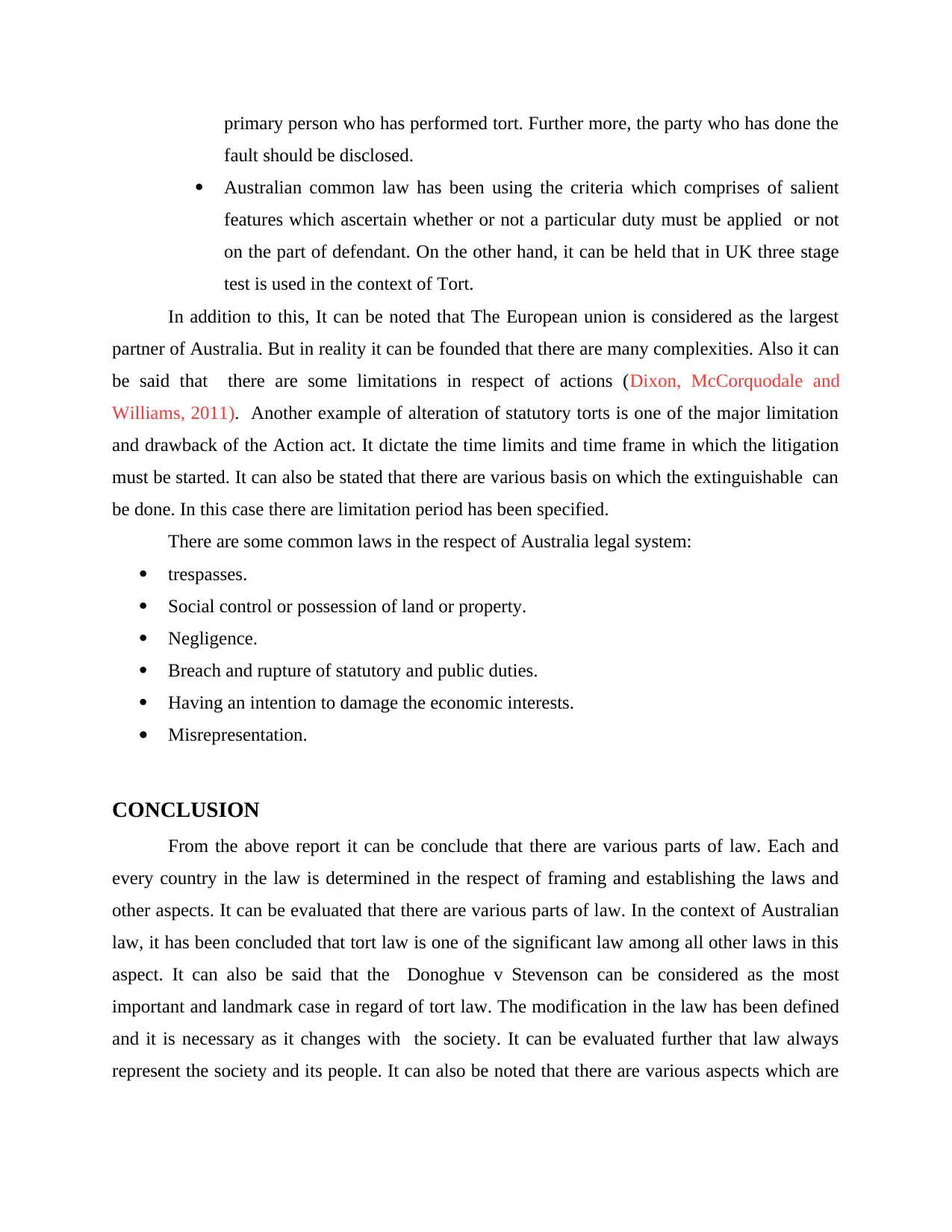
primary person who has performed tort. Further more, the party who has done the
fault should be disclosed.
Australian common law has been using the criteria which comprises of salient
features which ascertain whether or not a particular duty must be applied or not
on the part of defendant. On the other hand, it can be held that in UK three stage
test is used in the context of Tort.
In addition to this, It can be noted that The European union is considered as the largest
partner of Australia. But in reality it can be founded that there are many complexities. Also it can
be said that there are some limitations in respect of actions (Dixon, McCorquodale and
Williams, 2011). Another example of alteration of statutory torts is one of the major limitation
and drawback of the Action act. It dictate the time limits and time frame in which the litigation
must be started. It can also be stated that there are various basis on which the extinguishable can
be done. In this case there are limitation period has been specified.
There are some common laws in the respect of Australia legal system:
trespasses.
Social control or possession of land or property.
Negligence.
Breach and rupture of statutory and public duties.
Having an intention to damage the economic interests.
Misrepresentation.
CONCLUSION
From the above report it can be conclude that there are various parts of law. Each and
every country in the law is determined in the respect of framing and establishing the laws and
other aspects. It can be evaluated that there are various parts of law. In the context of Australian
law, it has been concluded that tort law is one of the significant law among all other laws in this
aspect. It can also be said that the Donoghue v Stevenson can be considered as the most
important and landmark case in regard of tort law. The modification in the law has been defined
and it is necessary as it changes with the society. It can be evaluated further that law always
represent the society and its people. It can also be noted that there are various aspects which are
fault should be disclosed.
Australian common law has been using the criteria which comprises of salient
features which ascertain whether or not a particular duty must be applied or not
on the part of defendant. On the other hand, it can be held that in UK three stage
test is used in the context of Tort.
In addition to this, It can be noted that The European union is considered as the largest
partner of Australia. But in reality it can be founded that there are many complexities. Also it can
be said that there are some limitations in respect of actions (Dixon, McCorquodale and
Williams, 2011). Another example of alteration of statutory torts is one of the major limitation
and drawback of the Action act. It dictate the time limits and time frame in which the litigation
must be started. It can also be stated that there are various basis on which the extinguishable can
be done. In this case there are limitation period has been specified.
There are some common laws in the respect of Australia legal system:
trespasses.
Social control or possession of land or property.
Negligence.
Breach and rupture of statutory and public duties.
Having an intention to damage the economic interests.
Misrepresentation.
CONCLUSION
From the above report it can be conclude that there are various parts of law. Each and
every country in the law is determined in the respect of framing and establishing the laws and
other aspects. It can be evaluated that there are various parts of law. In the context of Australian
law, it has been concluded that tort law is one of the significant law among all other laws in this
aspect. It can also be said that the Donoghue v Stevenson can be considered as the most
important and landmark case in regard of tort law. The modification in the law has been defined
and it is necessary as it changes with the society. It can be evaluated further that law always
represent the society and its people. It can also be noted that there are various aspects which are
Paraphrase This Document
Need a fresh take? Get an instant paraphrase of this document with our AI Paraphraser
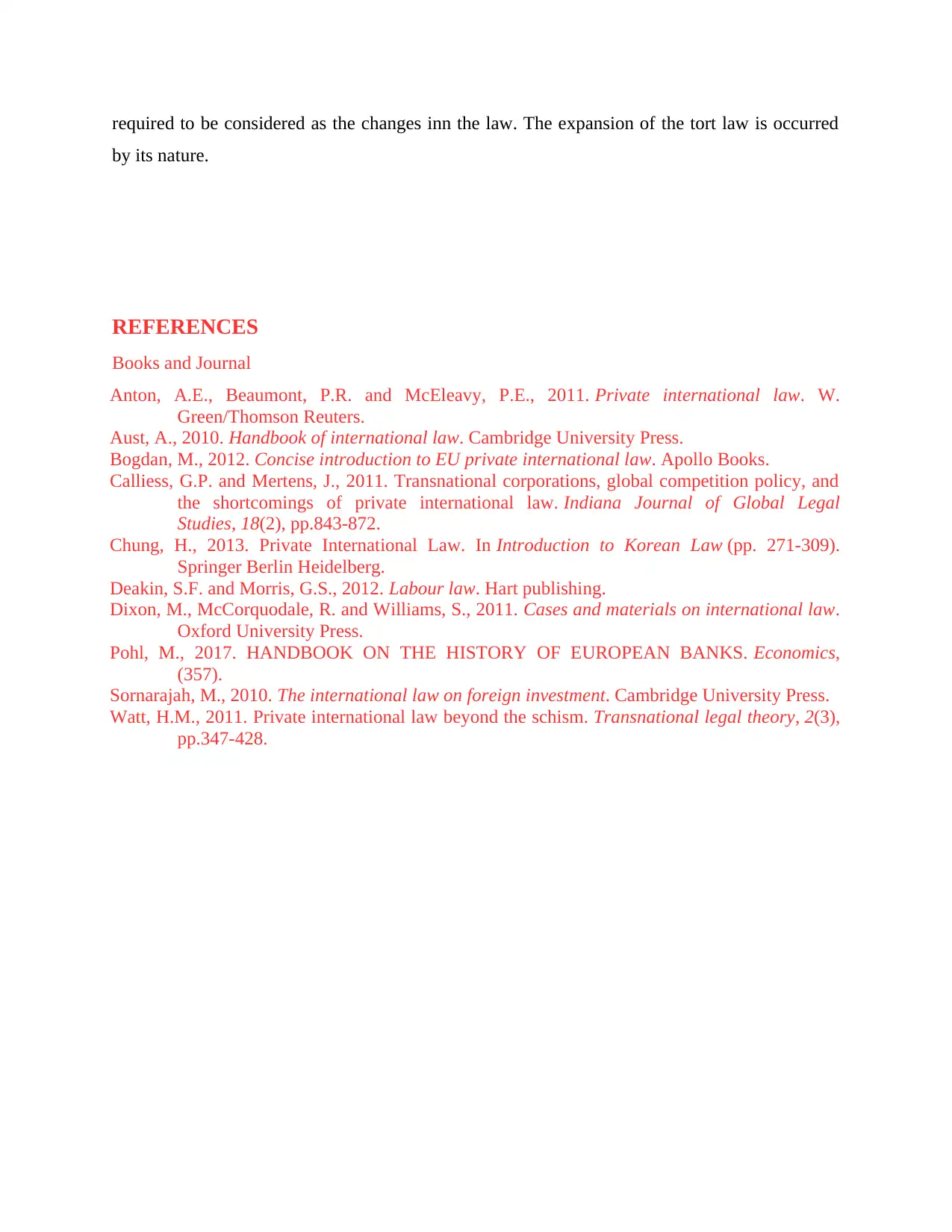
required to be considered as the changes inn the law. The expansion of the tort law is occurred
by its nature.
REFERENCES
Books and Journal
Anton, A.E., Beaumont, P.R. and McEleavy, P.E., 2011. Private international law. W.
Green/Thomson Reuters.
Aust, A., 2010. Handbook of international law. Cambridge University Press.
Bogdan, M., 2012. Concise introduction to EU private international law. Apollo Books.
Calliess, G.P. and Mertens, J., 2011. Transnational corporations, global competition policy, and
the shortcomings of private international law. Indiana Journal of Global Legal
Studies, 18(2), pp.843-872.
Chung, H., 2013. Private International Law. In Introduction to Korean Law (pp. 271-309).
Springer Berlin Heidelberg.
Deakin, S.F. and Morris, G.S., 2012. Labour law. Hart publishing.
Dixon, M., McCorquodale, R. and Williams, S., 2011. Cases and materials on international law.
Oxford University Press.
Pohl, M., 2017. HANDBOOK ON THE HISTORY OF EUROPEAN BANKS. Economics,
(357).
Sornarajah, M., 2010. The international law on foreign investment. Cambridge University Press.
Watt, H.M., 2011. Private international law beyond the schism. Transnational legal theory, 2(3),
pp.347-428.
by its nature.
REFERENCES
Books and Journal
Anton, A.E., Beaumont, P.R. and McEleavy, P.E., 2011. Private international law. W.
Green/Thomson Reuters.
Aust, A., 2010. Handbook of international law. Cambridge University Press.
Bogdan, M., 2012. Concise introduction to EU private international law. Apollo Books.
Calliess, G.P. and Mertens, J., 2011. Transnational corporations, global competition policy, and
the shortcomings of private international law. Indiana Journal of Global Legal
Studies, 18(2), pp.843-872.
Chung, H., 2013. Private International Law. In Introduction to Korean Law (pp. 271-309).
Springer Berlin Heidelberg.
Deakin, S.F. and Morris, G.S., 2012. Labour law. Hart publishing.
Dixon, M., McCorquodale, R. and Williams, S., 2011. Cases and materials on international law.
Oxford University Press.
Pohl, M., 2017. HANDBOOK ON THE HISTORY OF EUROPEAN BANKS. Economics,
(357).
Sornarajah, M., 2010. The international law on foreign investment. Cambridge University Press.
Watt, H.M., 2011. Private international law beyond the schism. Transnational legal theory, 2(3),
pp.347-428.
1 out of 8
Related Documents
Your All-in-One AI-Powered Toolkit for Academic Success.
+13062052269
info@desklib.com
Available 24*7 on WhatsApp / Email
![[object Object]](/_next/static/media/star-bottom.7253800d.svg)
Unlock your academic potential
Copyright © 2020–2025 A2Z Services. All Rights Reserved. Developed and managed by ZUCOL.





